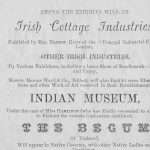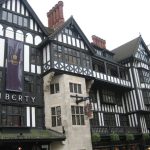The following was submitted by Seán Beattie, the editor of Donegal Annual
In April 1883, two wealthy middle-class travellers from Sydenham in London arrived in the north west. Their visit was no grand excursion, common in the nineteenth century, but was prompted by accounts in the English press about famine conditions in west Donegal. The location was no ordinary holiday destination by any means as the county had been the focus of land agitation during the Land War. Mass evictions on the Olphert estate in Falcarragh attracted international media interest and as journalists filed their reports to London they painted a gloomy picture of deprivation and hardship.
Alice and Ernest Hart were shocked at the news reports and decided to travel to Donegal to see the situation at first hand. Alice had studied medicine in Paris and her husband was a medical doctor and editor of The British Medical Journal. Both had a passion for charity work and as they came from a wealthy background, they had the resources to engage in philanthropic activity. Alice Hart’s father had acquired considerable riches as the owner of the Macassar Oil Company.
Alice immediately recognised that there was a shortage of work and decided to make an effort to generate employment. Weaving, spinning, knitting and embroidery were good sources of income in earlier decades but were in decline at this time. Collectively known as “cottage industries”, she decided to revive them as a means of raising family income. By 1884, the Donegal Industrial Fund (DIF) was in operation with a donation of £50 from her own resources. A series of letters were dispatched to newspapers eliciting contributions. She bought wool and distributed it to knitters to make socks and gloves which she sold to London outlets.
Her initial foray into the world of international business as an entrepreneur was not easy but with constant lobbying, she secured a grant of £1,000 from parliament in 1887. The money was voted for technical teaching and was earmarked for buildings, looms, equipment, salaries and teaching materials. A high profile committee was established to administer the Fund: the Earl of Leitrim, Archbishop Logue of Armagh, and the wife of the Viceroy, the Countess of Aberdeen. Alice Hart opened a technical school in Gweedore in November. Elsewhere, instruction was given in private houses and sheds. Initially she concentrated on teaching weaving with the help of a Yorkshire instructor but subsequently other subjects were introduced such as lace-making, sprigging and veining taught by local women.
Alice Hart had a great interest in lace and liked to dress up for her public appearances wearing the latest creations. To train workers to the highest international standards, she sent two Donegal women to Oxfordshire to learn the art of pillow lace-making, especially the Torchon and “Kells” style, the latter being a reference to the Kells industries she established throughout the country. Her intention was to train a large pool of skilled workers who would be competent to teach lace-making on a grand scale and develop a thriving industry. Trainees were encouraged to base their designs on drawings depicting old Celtic themes and images in the Books of Kells. On their return to Gweedore, the National Board of Education gave them permission to teach lace-making and embroidery at Knockestolar, Derrybeg and Dore. Lace classes were held in the Donegal Industrial Fund Technical School at Bunbeg. The Kells embroidery schools produced curtains, table cloths, book-covers and other household items. At the same time, 200 girls were trained in sprigging at Milford, Termon and Gweedore to supply the demands of the Belfast market. Within a short period, she had courses in operation from places as far apart as Teelin and Derrybeg. Techniques of dyeing, using vegetable dyes, were also taught. Classes were free and open to persons of all ages, the only requirement being a letter of commendation from the parish priest. Trainees sat examinations and prizes were awarded for the best work and for good attendance. Her attention to detail and her awareness of quality control were destined to be of significance later in the decade.
But Alice Hart knew that it was not enough to establish training courses and make fashionable lace. In the past, valuable expertise was lost as workers failed to find a market for their merchandise and their income dropped accordingly. With the assistance of the Countess of Aberdeen, she sold her lace to the Irish Lace Depot in Dublin. Because of her contacts in English society, she decided to set up Donegal House in Wigmore St., London to showcase Donegal lace, embroidery and tweed. Her husband knew one of the capital’s outstanding businessmen, Arthur Liberty, founder of the well-known fashion house also called Libertys off Regent St. in central London and he agreed to sell Donegal lace in his shop. Alice Hart’s philanthropy impressed members of the Debenham family, who operated a strict moral and ethical code in their workplace, and by the 1890s, the company was a major buyer of Donegal lace and tweeds. Lace making families in Malin Head were delighted to discover that their lace was being bought by Buckingham Palace. Queen Victorian bought lace curtains for the palace and the Prince of Wales treated himself to several pairs of shooting socks.
Trade exhibitions and World Trade Fairs were features of international business life in the late 1800s and early 1900s. Alice Hart had confidence in her workers and she exhibited their lace, embroidery and tweed in order to secure a foothold in competitive international markets. In 1888, her exhibits centred around a “Donegal industrial village” at the Olympia exhibition in London. The centrepiece was an Irish cross, a round tower and twelve thatched cottages forming a clachan where a team of Donegal workers demonstrated their lace-making and other skills to a world audience. Similar exhibitions were mounted in Derry, Dublin and Chicago and she frequently employed Irish speaking dancers to enliven the events. Alice Hart had indeed put Irish cottage industries on the world stage.
Donegal Prizewinners
In the 1891, Arthur Balfour established the Congested Districts Board to provide employment in poor areas. The Board consulted Alice Hart and decided to act in cooperation with her in the development of the cottage industries. By 1900, the Board had established Lace Schools all over the county, including Carrick, Glencolmcille, Ardara, and Carrigart. Although other subjects were taught including weaving, embroidery, stitching, crochet and knitting, the schools were popularly referred to as Lace Schools. Average attendance was thirty per class. Students were assisted in selling their goods to the Irish Lace Depot in Dublin so the schools had a modest role in raising family income. High standards were demanded: lace from Carrick, Glencolmcille and Ardara won awards at the Donegal industries show and at the RDS art industries exhibition in 1900. In 1908, Aileen Johnson’s Stranorlar Industries received a commendation for sprigging. Miss M. Johns, Rockfield, Stranorlar, won first prize for sprigging in 1912 and St. Louis Convent, Bundoran won an award against national competition. After completing training, women worked on lace, embroidery and crochet at home. Lace and crochet had to be clean before it was sent to the Irish Lace Depot so cleanliness in the home was essential. The work had a social value as women would gather in the evenings in one of the houses in the district and sing songs as they worked. Most of the work in winter evenings was by candlelight and unfortunately many women developed severe eyesight problems as a result of working long hours in poor light.
In the 1890s, there was a revival of interest in our Celtic past and lace became fashionable in social circles in London and Dublin. In ancient Ireland, embroidery was a special art practised by women. Needles were expensive and the price of a needle was an ounce of silver. Wedding dresses of the 1890s had a richness of embroidery and lace stitched to reveal Celtic themes. The Countess of Aberdeen insisted that her guests at the Lace Balls in the Vice-regal Lodge in the Phoenix Park would wear hand-made Irish lace, embroidery and crochet. At society soirées in London, hand-made Irish lace was highly regarded and was worn by titled ladies. Several landlord families became involved in lace and embroidery, the most notable being the Sinclairs of Drumbeg and the Hamiltons of Brownhall.
Fortunately for students of the Donegal Lace Schools, lace was a fashion item but all fashion trends come and go and so it was with lace and embroidery. The demise of the Lace Schools was due to the proliferation of cheap machine-made goods from Eastern Europe following the First World War. The Lace Schools could not compete so they closed down but the skills remained in the community for many years afterwards and the template of rural vocational training was copied subsequently when vocational schools were built.
In some parts of the county, a few Lace and Crochet Schools were established in the 1930s as part of adult education programmes. One such school was in the village of Carrowmena in Inishowen, where the instructor was a Miss Cassidy from Buncrana. Young women came from neighbouring townlands such as Ballyharry and Lecamy and were taught to embroider handkerchiefs and other household goods for agents who sold them in Belfast. Some of the women had previous experience of sewing shirts for the outstations of the shirt-making industry in Derry. The old thatched cottage where classes were held is still standing in the village, one of the last reminders of the sprawling, entrepreneurial cottage industries of a former age that once operated in Donegal. Times have changed but the Lace Schools may act as an inspiration for Donegal entrepreneurs today.
A more detailed review of Lace Schools in Donegal can be found in a chapter I have written in a new book, Poverty andWelfare 1838-1938, published by Irish Academic Press and Queen’s University, Belfast in 2011. See also www.historyofdonegal.com/articles for photos and an online study on Lace Schools in Donegal.
Sean Beattie websites:
 Today
Today  Tomorrow
Tomorrow 




